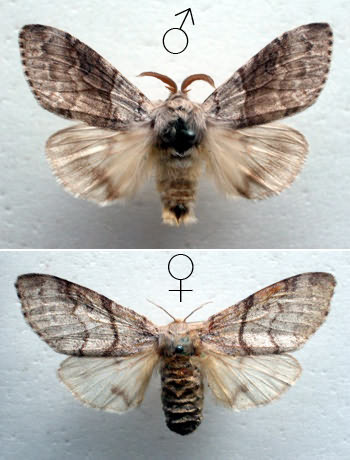Pests
Calliteara pudibunda L. - Pale Tussock Moth
Systematic position.
Class Insecta, order Lepidoptera, superfamily Noctuoidae, family Lymantriidae, subfamily Calliterinae, genus Calliteara.Synonyms.
Dasychira pudibunda L., Elkneria pudibunda L.Biological group.
Polyphagous pest of fruit trees and bushes.Morphology and biology.
Sexual dimorphism. Females larger than males (wingspan 35-60 mm in females, 35-45 mm in males). Male antenna strongly pectinated with yellow-brown pectens and white segments. Female antenna with short yellow-brown pectens. Female forewing yellowish-gray with brown pollination and 2-3 darker, wavy transverse stripes. Hindwing light gray with dim dark transverse stripe and dark spot at anterior margin. Male forewing ash-gray or dark gray. Egg is light gray with bluish tint. Caterpillar is covered with dense hairs, usually primrose-yellow, sometimes pink, gray, or dark brown with dorsal brushes of the same color. Body apex has red or crimson dorsal brush consisting of long erect hairs and looking like a small tail. Body dorsum with black transverse stripes between brushes. Pupa dark brown with yellowish-red hairs and clavate processes at apex. The pupae winters within thin brownish-gray double-webbed cocoons, between fallen leaves on ground surface, fastened with silky threads, Pupation occurs between leaves, on the lower side of fallen trunks and in other places. Females lay eggs by 10-400 (100 on average) in one-layer batches on bark of trees at height of 3-4 m; the batches are not covered with hairs. Fertility is 1,000 eggs. During the periods of mass outbreaks, the average quantity of eggs reaches 10,000 on a tree. Egg batches are met in different places, even on ground.Distribution.
Western Europe (almost everywhere), Afghanistan, Asia Minor. In the USSR, the species is distributed in all European part (except for the Far North), in Cis-Ural and Volga regions, in Western Siberia, the Far East (Primorski Krai), Baltic States, Byelorussia, Ukraine, Moldova, Northern Caucasus, Transcaucasia, Kazakhstan, Central Asia (mountains, locally).Ecology.
Usually monovoltine species, sometimes developing in the south incomplete 2nd generation under favorable conditions. Moderately hygrophilous species. Moths fly in mid-April (Transcaucasia) or in May - June (Russia). Imagoes are active at night, hiding in tree crowns or on trunks in the daytime. They leave cocoons in the afternoon (12-16 h p.m.). Immediately after emergence they mate, being in copula for many hours. Caterpillars hatch from the middle of May in the south, and the 2nd half of June in Russia. Young caterpillars are passive migrants. Harming activity is significant from the end of July to mid-September. Caterpillars develop three and more months. the species has 2 retardation periods in development, summer and winter diapauses. Pupae develop during 10 days. Caterpillars have additional molts with decreased rate of growth during increased temperatures and long daytime. The pupation and resting period in nature begins in the 2nd half of August, the middle of September, or (in the south) in October. Fluctuations of population dynamics depend significantly on numerous entomophages including heteropteran and dipteran parasites.Economic significance.
In some years the species is a significant pest of various rosaceous cultures, especially pears, apples, hawthorn, raspberry, roses, bird cherry and other stone-fruit plants in orchards; hazel, birch, hornbeam, hop, oak, beech, chestnut, willow, poplar, linden, etc. in parks and roadside plantings in the south of Russia and in Ukraine. Caterpillars skeletonize and pierce leaves, gnaw around leaf and flower buds; older ones completely eat leaves. The Pale Tussock is very harmful during mass outbreaks when the caterpillars damage deciduous forests and young plantings of rosaceous. This damage results in reduction of fruit yield in orchards and decrease of forest accretion. The mass outbreaks of the pest are local and sporadic.Reference citations:
Danilevskii A.S. 1961. Photoperiodic response and seasonal development of insects. Leningrad: LGU, 243 p. (in Russian).Geispits K.F. & Zarankina A.I. 1957. Features of photoperiodic reaction of Dasychira pudibunda L. (Lepidoptera, Orgyidae). Entomologicheskoe obozrenie 42(1): 29-39 (in Russian).
Kuznetsov V.I. 1999. Lymantriidae (Liparidae, Orgyidae). In: Kuznetsov V.I., ed. Insects and mites . pests of agricultural plants. V. 3(2). Lepidoptera. St.Petersburg: Nauka: 279-320 (in Russian).
Nekrutenko Yu.P. 1974. Lymantriidae. In: Vasil.ev V.P., ed. Pests of agricultural crops and forest plantations. V.2. Arthropods. Kiev: Urozhai: 357-361 (in Russian).
Savkovskii P.P. 1976. Atlas of the pests of fruit and berry plants. Kiev: Urozhai. 207 p. (in Russian).
Shtakel.berg A.A., ed. 1955. Forest pests. Reference book. Moscow & Leningrad: AN SSSR, V. 1, 1097 p. (in Russian).
Vasil.ev V.P. & Livshits I.Z. 1984. Pests of fruit crops. Moscow: Kolos, 399 p. (in Russian).
Vorontsov A.I. 1982. Forest entomology. Moscow: Vysshaya shkola, 384 p. (in Russian).


